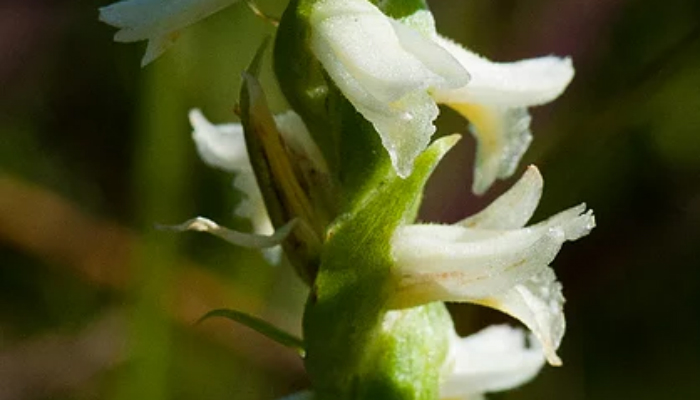Origins of an at-risk species

David Cordray details his findings of an at-risk orchid and hypothesizes on how it may have come to be. These musings show the many and varied ways that native and non-native species may move into new areas.
Every fall, I dedicate time for hunting isolated clumps of reed canary grass – an invasive species – in the wetland restorations I manage. Reed canary grass typically stays green longer than most of the native plants, allowing an “experienced eye” to pick it out quickly among the masses of fall-colored vegetation. On this day, I’m walking along the shore of a shallow, human-made wildlife pond, scanning carefully through the thick herbaceous vegetation for reed canary grass, when I spot a tiny little plant with white flowers just above the high-water line. I bend down for a closer look, and recognize the plant as a lady’s-tresses. Its sweet scent (some say it smells like vanilla, others almonds) and lack of basal leaves reveals its full identity as a Great Plains Lady’s-tresses, a member of the orchid family. How the heck did this little guy get here?
According to the Wisconsin DNR, the Great Plains Lady’s-tresses is an at-risk species, mostly associated with dry prairies but sometimes found in wetter prairies and occasionally fens, a type of wetland. This rare orchid produces tiny, dust-like seeds that are believed to disperse mainly by the wind. As I understand it, the tiny seeds lack an endosperm, or food reserve, and are unable to germinate on their own. They have to engage in a mycorrhizal relationship with a fungus that helps feed the emerging seedling. Okay, I think, the plant is here. So clearly it found the right fungus needed for germination. But how did the seed get here?
Immediately, my mind goes through the mental exercise of trying to solve this little mystery. The pond was created, in 2002, by widening a deep farm-field erosion gully and installing an earthen dam. All the land surrounding the pond, except for a small buffer area, was farmed until 2008 when the upslope agricultural fields were converted to prairie. Farther upslope from the planted prairie are steep ridges of oak woodland and oak savanna, which we have been restoring since 2001. Until today, I haven’t found this species of lady’s-tresses anywhere on the property. I do know of a population of this orchid in a small dry-mesic prairie remnant, but it’s five miles away as a crow flies.
Could it have blown in from the wind? From the orchid seed dispersal studies I’ve read, seed dispersal distances are measured in short lengths of a few meters. While the property this orchid resides on is responding well to ecological restoration, and its biodiversity is increasing, the neighboring lands are either row-crop agricultural fields or heavily canopied woodlots overrun with invasive species. It would seem that if the seed came in from the wind, it would have originated from the same property where the discovered orchid now resides. And while I haven’t found this species on this property before today, the plants are very small, and it’s possible they were here, and I missed them. Assuming the orchids have been here and not discovered, the likely source would be the oak savanna, which is hundreds of meters away from the small pond. Therefore, for this to be plausible, wind seed dispersal distances would need to be hundreds of meters, and from an undiscovered population residing on the same property.
Could it have hitched a ride on the fur or hair of an animal? From my literature review, I could only find references to wind seed dispersal for orchids. However, it seems feasible that a little dust-like orchid seed could stick on or in the fur of a far-ranging mammal like a mink and find its way to this little pond.
Could it have washed in from rain water or snow melt? All the watershed for the small pond, except for a couple of acres, comes from within the property where the orchid was found. In addition, the discovered orchid was found on the pond shoreline just above high-water mark, which is suggestive that the orchid seed could have been floating on the water’s surface during a high-water event and deposited on shore by receding water and/or lapping waves. The orchid seed would just have to find its way on the property, by whatever method, and then rain water or snow melt could carry it to the pond.
Could it have hitched a ride on the feather of a duck, goose or shore bird? Every spring and fall the pond is visited by many species of migrating waterfowl and shorebirds. Habitat descriptions for the Great Plains Lady’s-tresses varied from dry to wet from the many references I found, but it seems that on the northern range of the orchid’s distribution, there were many more references to a preferred habitat of wet prairies and fens. Therefore, it seems plausible that a duck or shorebird could have transported the orchid seed to the pond shoreline.
Could it have hitched a ride on my clothing or boots? As stated earlier, I do manage another property that has a healthy population of this orchid species. While I’m dogged about cleaning my boots and clothing between different sites, there is no way I can claim that an orchid seed didn’t tag along with me. Individual seeds are nearly impossible to see, so this could be a plausible explanation.
At this point, my head hurts and I have to stop over analyzing everything. I’m just thankful this rare orchid found its way here, and I hope it multiplies in number by whatever unknown-to-me method it chooses for dispersing its seed!
Originally published on Environmental Returns
Tags: David Cordray, native, non-native, species introduction

